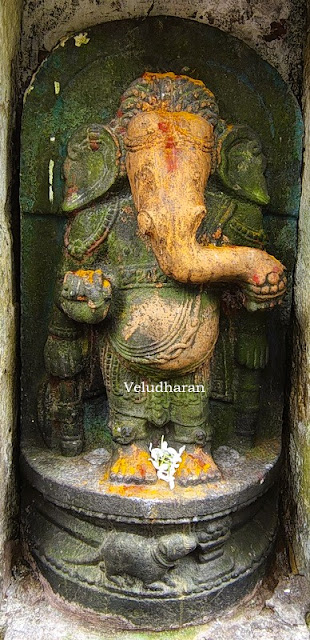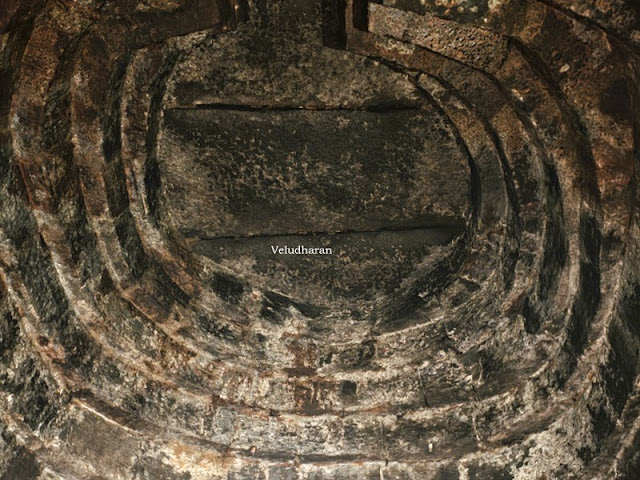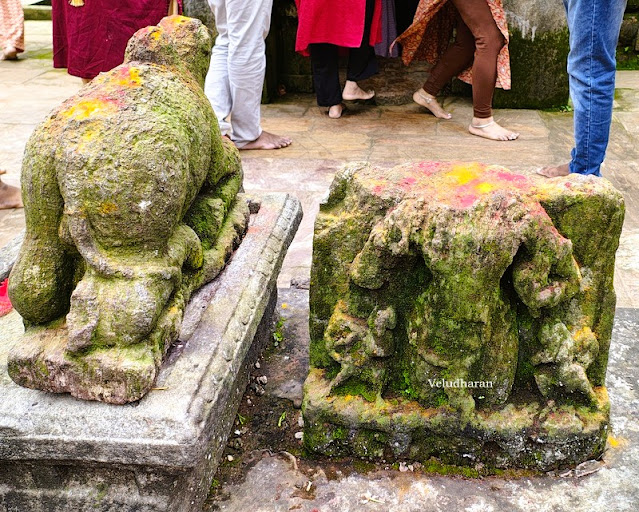The visit to this Sri Kunti
also called Sri Gokarneswara Temple at Mahendragiri, Odisha was a part of the “Kalinga and Ottara Desa Heritage Walk” organised by சோழ மண்டல வரலாற்றுத் தேடல் குழு, between 13th to 18th
September 2024. The purpose of this Heritage walk was to see the places,
monuments, etc., which are directly or indirectly connected as a proof of
Rajendra Chozha’s victory mentioned in his meikeerthi/title over Kalinga and
Ottara Desa, the present Andhra Pradesh and Odisha.
This Kunti temple is one of
the Shiva temples built during the 10th to 11th Centuries in Ottara Desam, presently called Odisha State. There was no proper road to access this temple until the 20th Century. The Odisha government is forming and widening roads as part of Tourism Development. This temple is about 2 km from Yudhistar Temple, and Mahendragiri
Ashram is close to the temple.
Moolavar :
Sri Gokarneswara
Consort :
Sri Parvati
Some of the salient features of this temple are….
The temple faces west with only the sanctum sanctorum. The Sanctum Sanctorum is about
4 feet below the ground level with a Shiva Lingam. A Rishabam is in front of
the Sanctum Sanctorum. In Koshtam, Vinayagar, Karthikeyan and Parvati.
Fragment sculptures like
Garuda, and unidentified sculptures are found near Rishaba. Also, there is a sannidhi in front of the
ARCHITECTURE
This west-facing temple, also known as
Gokarneswara, consists of a deula/Vimanam only. The temple is of the Rekha (curvilinear)
order and pancha-ratha on plan with the jangha (middle portion) having a single-storey design. The Pagas (Vertical projections) are not carved. The niches/
Devakoshtas on the rahapagas house the standard Saivite Parva-devatas ie.
Ganesh, Kathikeya, and Parvati. The
lintel is carved with a Navagraha panel, where Ketu is depicted in full human
form seated in padrasana. The whole body of the temple is devoid of any art.
The only decorative element on the gandi (body) is an alignment of
anga-akharas (miniature spires) above the entrance.
The lintel is carved with a Navagraha panel, where Ketu is depicted in full human form seated in padrasana.
Inside view of the Deula/ Vimanam
HISTORY AND INSCRIPTIONS
On stylistic grounds, this temple can be dated to the 12th to 13th Century CE. Several fragments of sculptures lying in the temple, and premises, and three pars images seem to be earlier than this
temple.
The meikeerthi of Rajendra Chozha mentions the Victory
over the Bengal, the northern part of India, in a war. The meikeerthi/title goes like
this…..
ஸ்வஸ்திஸ்ரீ
திருமன்னி வளர இருநில மடந்தையும்
போர்செயப் பாவையும் சீர்தனிச் செல்வியும்
தன்பெருந் தேவியர் ஆகி இன்புற
நெடிதியல் ஊழியுள் இடதுறை நாடும்
…….. ……
…….
தங்காத சாரல் வங்காள தேசமும்
தொடுகடல் சங்கு கொட்டன்மகி பாலனை
வெஞ்சமர் வளாகத்து அஞ்சுவித் தருளி
ஒன்திறல் யானையும் பெண்டிர்பண் டாரமும்
…….. ……. ……..
தொடுகடற் காவல் கடுமுரண் கடாரமும்
மாப்பொரு தண்டாற் கொண்ட
கோப் பரகேசரி பன்மரான
உடையார் ஸ்ரீஇராசேந்திர சோழ தேவர்க்கு யாண்டு
The 6 line
inscription on the lintel of the Yudhistra Temple’s Sanctum Sanctorum entrance,
in Nagari and the Royal Emblem of Twin fish & the squatting Tiger are the
proof of Rajendra Chozha’s meikeerthi as real.
The 6-line inscription records the Victory of Vimaladitya, the King of Kulootha. He captured the mountains like the Elephants of Kalinga Kings, Killed some of them, and his Chieftain installed a Victory Sthambha in a place where the evening Sun shines.
One of the three inscriptions
at this Kunti Temple records this. This inscription is now paved with stones as
steps. The first inscription reads as….
கல்வெட்டு -1
1. …… னணயும் எறி
2. …… ஹேந்திர
3. …… ண்டு ஸரீ மகேந்திர
4. …… த்தில் ஜெயஸ்தம்பம் நாட்
(சில
மன்னர்களை வெற்றி கண்டு (எறிந்து) மகேந்திர கிரி இம்மலையில் வெற்றித்தூண் நாட்டப்பட்டதை
குறிப்பிடுகின்றது).
The other two inscriptions are on both sides of a
doorway of a small shrine (Parivara shines without deities), in front of the
main temple. One of them written in early Nagari and Telugu is on a slab to the
right entrance, datable to 1123 CE, which records the gift of a lamp to the
temple of Mahendreswara suggesting that there existed a temple of this name at
this site.
கல்வெட்டு- 2
1. ஸரீ மகா
2. நாயக் இராஜேந்திரசோழ
3. ப்பல்லவராயன் இராஜராஜ
4. மாராயன் மகேந்திர கிரீஸ்வரத்து கொ
5. ஸ்டான் வீராங்குசமும் விட்டி
6. வாரண மல்ல
(இராஜேந்திர சோழ பல்லவ ரையன் என்னும் இராஜராஜ மாராயன்
என்ற படைத்தலைவன் மகேந்திரகிரீஸ்வரம் என்ற ஆலயத்தில் வீர அங்கு சத்தையும், விட்டி
வாரணமல்லன் (விமலாதித்தன் என்பவனை
கலங்கடித்தான்) என்ற பட்டத்தையும் பெற்றதை இக்கல்வெட்டு
குறிப்பிடுகின்றது.
கல்வெட்டு -3
1. விமலாதித்தனை
2. யுங் கலங்கருத்தான்
(விமலாதித்தன் என்பவனை கலங்கடித்தான்)
இப்போர் குறித்து திருவாலங்காடு செப்பேடு கீழ்க்கண்ட
தகவல்களை தருகிறது . இராஜேந்திர சோழனை தாக்க முற்பட்ட
ஒட்ர நாட்டுப் பட்டத்து யானையை தாம் வீற்று இருந்த யானையைக் கொண்டு வீழ்த்தி
கொன்றான் என்றும், ஒட்ர தேச அரசனையும் அவனது தம்பியையும் கொன்று, அவர்களது யானைப் படையை
கைக்கொண்டதாகவும் செப்பேடு குறிப்பிடப்படுகிறது.
The Thiruvalangadu
Cheppedu/Copperplate records this war. In that Rajendra Chozha Killed the
Ottara Desa Royal Elephant, sitting on his Elephant. Also, he killed the Ottara
Desa King and his brother. As per the Historians, The Ottara Desa King may have been South Kosala King Indrarathan and his brother Nagusan. During that period the
Ottara Desa was under the control of Then Kolam. Vimadithan was chased away
from the country.
Further, the copper plate
records that the Chieftain Rajendra Chozha Pallavaraiyan, who was responsible
for this Victory was conferred with the title of VittivaaraNamallan, and a Vira
angusam was also gifted. Historians believe that the title was given to
the Chieftain on the installation of the Victory Sthamba ceremony and conferring the
title, can only be done by the king. Hence it is presumed that Rajendra Chozha was involved in the war and received the Ganga water, waiting at the Godavari
River bank.
Ref
The ASI Display board in front of the temple.
Dr. Sivaramakrishnan
LOCATION OF THE TEMPLE : CLICK HERE
--- OM SHIVAYA NAMA ---


















No comments:
Post a Comment